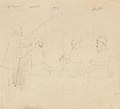Baba Buddha
Baba Buddha Ji | |
|---|---|
ਬਾਬਾ ਬੁੱਢਾ | |
 Fresco depicting Baba Buddha with an identifying Gurmukhi inscription, Gurdwara Baba Bir Singh, circa 19th century | |
| Personal | |
| Born | Bura Randhawa 6 October 1506 Kathu Nangal, Amritsar, India |
| Died | 8 September 1631 (aged 124) Jhanda Ramdas |
| Religion | Sikhism |
| Children | Bhai Bhana (1536-1644) |
| Parent(s) | Bhai Sukha Randhawa (father) Mai Gauran Sandhu (mother) |
| Known for | Early figure of Sikhism |
| Part of a series on |
| Sikhism |
|---|
 |
Baba Buddha (Gurmukhi: ਬਾਬਾ ਬੁੱਢਾ; bābā buḍhā; lit. meaning "wise old man"; 6 October 1506 – 8 September 1631) was a prime figure in early Sikhism.[1]
Early life
[edit]He was born to a Jat[2] family on 1506 in the village of Kathu Nangal in Amritsar . His father's name was Sukha Randhawa and his mother was named Mai Gauran. His birth name was Bura (Gurmukhi: ਬੂੜਾ; būṛā).[3] As a child, while grazing cattle outside his village, he met Guru Nanak. He asked Guru Nanak many questions regarding life and death, such that, at his young age, Guru Nanak blessed him with the name Buddha, as he spoke as if he were a wise elder.
Spiritual career
[edit]He was one of the earliest Sikhs of Guru Nanak, and performed the formal coronation ceremonies of the five Sikh gurus who succeeded Guru Nanak; Guru Angad, Guru Amar Das, Guru Ram Das, Guru Arjan, and Guru Hargobind.[4][5]
On installation of the Adi Granth, a compilation of Sikh scripture, at Sri Harimandir Sahib on August 16, 1604, Bhai Buddha was appointed the first Granthi by Guru Arjan.[6]
When Bhani (daughter of Guru Amar Das) had a jagir land grant (consisting of 500 biggas) of productive agricultural land bestowed upon her by the Mughal emperor Akbar, Baba Buddha was administrator of the land.[7] The land became known as 'Beer Baba Buddha Ji' as a result.[7] The land had a gurdwara constructed upon it, was used for farming, and educational activities.[7]
Ganga, wife of Guru Arjan, sought out Baba Buddha for his blessings when Ganga desired to give birth to a son in-order to have an heir to the guruship.[8][9] After a failed first attempt, Baba Buddha eventually granted her wish and blessed her.[8][9] Guru Hargobind was born to Ganga after this blessing.[8][9]
Military career
[edit]According to Sikh hagiographies and oral histories, Baba Buddha learnt the Sikh martial art system of Shastar Vidya from Guru Nanak himself.[10] Baba Buddha provided the successive gurus of Nanak training in the martial art and was ordained by Guru Hargobind to instruct recruits into the first Sikh army, in Shastar Vidya.[10]
On May 30, 1606, after the martyrdom of Guru Arjan, Guru Hargobind ordered the construction of the Akal Takht and entrusted the responsibility of its construction to Baba Buddha and Bhai Gurdas.[1] While Guru Hargobind was in jail, Baba Budha reformed the Nihang army, at the time called the Akal Sena, although now it is named the Budha Dal after Jathedar Baba Budha Randhawa.[citation needed]
Death
[edit]After a lifetime of following the Sikh Gurus, Baba Buddha died at the age of 124 in 1631 at the village of Jhanda Ramdas, on the banks of the Ravi River. Guru Hargobind was at his bedside and honoured him by carrying him to his funeral pyre and reciting passages from the Adi Granth.
Gallery
[edit]-
Baba Buddha, as a young boy, seeks the blessings of Guru Nanak. Pahari, brush drawing, from the family workship of Nainsukh of Guler, last quarter of the 18th century.
-
Baba Buddha crowning the fifth guru
-
19th century drawing of Guru Arjan meeting Baba Buddha and Bhai Gurdas
See also
[edit]References
[edit]- ^ a b "BUḌḌHĀ BĀBĀ (1506-1631)". eos.learnpunjabi.org. Retrieved 2019-08-29.
- ^ McLeod, W. H.; Fenech, Louis E. (2014). Historical Dictionary of Sikhism (3rd ed.). Rowman & Littlefield. p. 73. ISBN 978-1-4422-3600-4.
BUDDHA, BHAI or BABA (trad. 1506–1631). A Jat from Kathu Nangal, who was originally called Bura Randhava.
- ^ "Baba Budha | Discover Sikhism". www.discoversikhism.com. Retrieved 2022-08-19.
- ^ Singha, H. S. (2000). The Encyclopedia of Sikhism (over 1000 Entries). Hemkunt Press. ISBN 9788170103011.
- ^ Khalsa, Gurutej Singh (2014-08-23). Rajni. Trafford Publishing. ISBN 9781490743301.
- ^ Singh, Harjinder (12 September 2022). "From Pothi to Guru Granth Sahib: The Perfect-Genius of Guru Arjan Sahib". Sikh Research Institute.
Guru Arjan Sahib asked his Sikh, Baba Buddha (1506–1631), to be the first Granthi (the one who knows the Granth) to be the custodian at Sri Harimandar Sahib. Baba Buddha was carrying the Granth on his head; Guru Arjan Sahib was waving the chaur (royal-whisk). The beautiful revered Harigobind was also part of the procession. Atmosphere was divine: sound of many sankh (conch), vibrations of dundabhi (drums), and cheers of jai-jai-kar (hail or praise).
- ^ a b c Singh, Prithi Pal (2006). The History of Sikh Gurus. Lotus Press. pp. 55–56. ISBN 9788183820752.
- ^ a b c Singh, Prithi Pal (2006). The History of Sikh Gurus. Lotus Press. pp. 67–69. ISBN 9788183820752.
- ^ a b c Jain, Harish (2003). The Making of Punjab. Unistar Books. p. 275.
- ^ a b Singh, Kamalroop (2014). "38. Sikh Martial Art (Gatkā)". In Singh, Pashaura; Fenech, Louis E. (eds.). The Oxford Handbook of Sikh Studies. Oxford Handbooks Online. Oxford University Press. pp. 459–470. doi:10.1093/oxfordhb/9780199699308.013.022.
- gurbilas Chhevin Patshahi. Patiala, 1970
- Bhalla, Sarup Das, Mahima Prakash. Patiala, 1971
- Padam, Piara Singh, and Gianl Garja Singh, eds., Guru ban Sakhlari Patiala, 1986
Further reading
[edit]- Randhāwā, Gurdīp Siṅgh (2002). "BUḌḌHĀ, BĀBĀ (1506–1631)". In Singh, Harbans (ed.). The Encyclopaedia of Sikhism. Vol. I (4th ed.). Punjabi University. pp. 399–400. ISBN 978-81-7380-100-6. OCLC 808441524.
- Gupta, Hari Ram (1994) [1984]. History of the Sikhs. Vol. I: The Sikh Gurus, 1469–1708 (2nd rev. ed.). Munshiram Manoharlal. pp. 360–364. ISBN 978-81-215-0276-4. OCLC 773483227.



